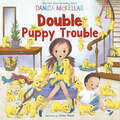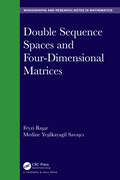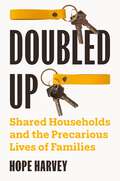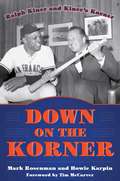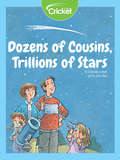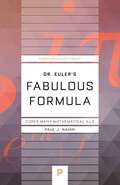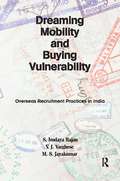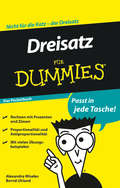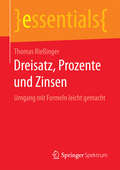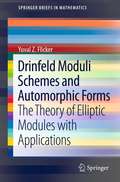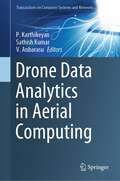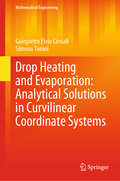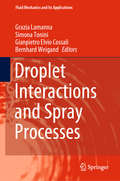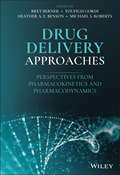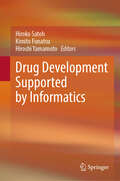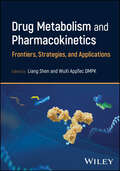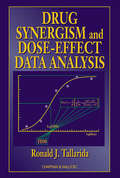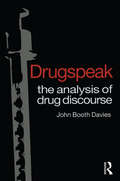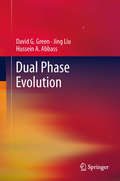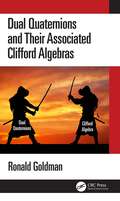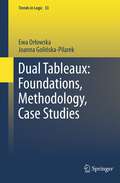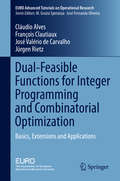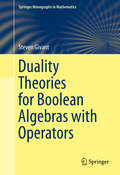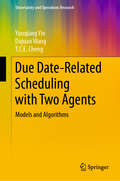- Table View
- List View
Double Puppy Trouble (McKellar Math)
by Danica McKellarThe newest math-focused picture book from New York Times bestselling author Danica McKellar is full of puppy-fueled chaos and a message of gratitude, with a double helping of fun!Moxie Jo always wanted MORE. But soon she'd get MORE than she bargained for!Spunky and energetic, Moxie is just like any other girl--aside from the fact that she has to have the MOST of everything! If she doesn't have the most toys, the most A's on tests, or the most time on the swing, then she makes the MOST noise! So when Moxie finds a magic stick that can double anything, she doesn't hesitate to use it--but when the button gets stuck, she may start to realize that less really is more! Teach the power of doubling through this playful puppy romp!
Double Sequence Spaces and Four-Dimensional Matrices (Chapman & Hall/CRC Monographs and Research Notes in Mathematics)
by Feyzi Başar Medine Yeşilkayagil SavaşcıDouble Sequence Spaces and Four-Dimensional Matrices provides readers with a clear introduction to the spaces of double sequences and series, as well as their properties. The book then goes beyond this to investigate paranormed double sequence spaces and their algebraic and topological properties, triangle matrices and their domains in certain spaces of double sequences, dual spaces of double sequence spaces, and matrix transformations between double sequence spaces and related topics. Each chapter contains a conclusion section highlighting the importance of results and pointing out possible new ideas that can be studied further. Features Suitable for students at graduate or post-graduate level and researchers Investigates different types of summable spaces and computes their duals Characterizes several four-dimensional matrix classes transforming one summable space into other Discusses several algebraic and topological properties of new sequence spaces generated by the domain of triangles.
Doubled Up: Shared Households and the Precarious Lives of Families
by Hope HarveyHow sharing a home with extended family or friends serves as a crucial, but imperfect, private safety net for families with childrenMore than fifteen percent of US children—over eleven million—live in doubled-up households, sharing space with extended family or friends. These households are even more common among low-income families, families of color, and single-parent families, functioning as a private safety net for many in a country with extremely limited public support for families. Yet despite their prevalence, we know little about how shared households form and how they shape family life. Doubled Up is an in-depth look at the experiences of families with children living in doubled-up households.Drawing on extensive interviews with sixty parents living in doubled-up households, Hope Harvey examines what circumstances and motivations lead families to form doubled-up households, how living in shared households affects daily routines, and how families fare after these arrangements dissolve.Harvey shows that although families rely on doubling up to get by in the face of rapidly rising housing costs, precarious labor markets, and unaffordable childcare, these private arrangements are rarely sufficient to overcome such structural barriers. And doubling up incurs its own costs for both host and guest families. For doubled-up families, negotiating household relationships and navigating shared space reshapes family life. Understanding the dynamics of doubled-up households extends scholarship on family life beyond the nuclear family and points the way toward better policies that will serve all families.
Down on the Korner: Ralph Kiner and Kiner's Korner
by Mark Rosenman Howie Karpin Tim McCarverOne of the staples of the long and storied history of baseball on television is the "postgame show,” and none was more beloved than Kiner’s Korner. From the early 1960s into the 1990s, Hall of Famer and iconic broadcaster Ralph Kiner hosted the show that brought players into the homes of fans across the nation.From the host, to the set, to the guests, to the stories amassed over more than thirty-two years on the air, Down on the Korner takes the reader behind the scenes. Authors Mark Rosenman and Howie Karpin gather insight from baseball greats like Ed Charles, Ron Darling, Pete Falcone, "Doc” Gooden, Keith Hernandez, Tim Harkness, Ron Hunt, Howard Johnson, Darryl Strawberry, Bobby Valentine, and many more. People who worked behind the scenes provide memorable moments of their own-like the time producer Jack Simon joined Jerry Koosman to play a practical joke on Hall of Famer and legendary Met Tom Seaver.Throughout his career as a player and broadcaster, Ralph Kiner was adored by millions of fans. His postgame show only strengthened that bond. Down on the Korner will give readers a wonderful ride down sports’ memory lane-an enjoyable journey for any baseball enthusiast.Skyhorse Publishing, as well as our Sports Publishing imprint, are proud to publish a broad range of books for readers interested in sports-books about baseball, pro football, college football, pro and college basketball, hockey, or soccer, we have a book about your sport or your team.Whether you are a New York Yankees fan or hail from Red Sox nation; whether you are a die-hard Green Bay Packers or Dallas Cowboys fan; whether you root for the Kentucky Wildcats, Louisville Cardinals, UCLA Bruins, or Kansas Jayhawks; whether you route for the Boston Bruins, Toronto Maple Leafs, Montreal Canadiens, or Los Angeles Kings; we have a book for you. While not every title we publish becomes a New York Times bestseller or a national bestseller, we are committed to publishing books on subjects that are sometimes overlooked by other publishers and to authors whose work might not otherwise find a home.
Dozens of Cousins, Trillions of Stars
by Charnan SimonIt's the Hill family annual stargazing party! With camping and hot cocoa, the thirteen cousins observe the night sky together.
Dr. Euler's Fabulous Formula: Cures Many Mathematical Ills (Princeton Science Library #52)
by Paul J. NahinIn the mid-eighteenth century, Swiss-born mathematician Leonhard Euler developed a formula so innovative and complex that it continues to inspire research, discussion, and even the occasional limerick. Dr. Euler's Fabulous Formula shares the fascinating story of this groundbreaking formula—long regarded as the gold standard for mathematical beauty—and shows why it still lies at the heart of complex number theory. In some ways a sequel to Nahin's An Imaginary Tale, this book examines the many applications of complex numbers alongside intriguing stories from the history of mathematics. Dr. Euler's Fabulous Formula is accessible to any reader familiar with calculus and differential equations, and promises to inspire mathematicians for years to come.
Dreaming Mobility and Buying Vulnerability: Overseas Recruitment Practices in India
by S. Irudaya Rajan V. J. Varghese M. S. JayakumarIn the alarming contemporary context of widespread corruption and fraudulence in the overseas labour recruitment system in India, this book attempts to understand the institution of emigration governance and recruitment practices in the country with a focus on the unskilled and semi-skilled sectors. It brings together the results of research in the major emigration hubs of India with the aid of quantitative and qualitative tools, drawing from all the major stakeholders —intending emigrants, recruiting agents, return emigrants, emigrant households, Protector of Emigrants, foreign employers, foreign recruiting agents, Indian missions and emigrant workers at the destination countries. The book unravels the underlying discriminatory rationality of the existing system of emigration governance, its logical and structural incoherencies and the consequent inefficacy in protecting the most vulnerable sections of workers leaving India for overseas employment, resulting in unaffordable levels of transaction and social costs. By outlining the institutional failure, the volume outlines the fundamental principles of a new institution which would facilitate orderly, safe and secure emigration, economically sustainable beneficial expatriate life and social protection after the emigrants return. The book will be of interest to students and scholars of sociology, law, economics, demography, anthropology, history, gender studies, cultural studies, Diaspora studies, migration studies and international relations, apart from policy-makers and administrators of transnational migration and NGOs working in the field of migration.
Dreisatz fur Dummies Das Pocketbuch (Für Dummies)
by Alexandra Miseles Bernd UhlandWer hat ihn nicht gelernt, den Dreisatz? Aber wie fit sind Sie in diesem Thema? Dabei ist Dreisatzrechnen sehr praktisch und einmal begriffen, erleichtert es den Umgang mit der Mathematik ungemein. Bernd Uhland und Alexandra Miseles bringen Ihnen in diesem kleinen Buch schnell bei, was Sie über den Dreisatz wissen sollten. Sie erklären Ihnen das grundlegende Rechenverfahren und zeigen Ihnen, was es mit zusammengesetzten Dreisätzen auf sich hat. Natürlich kommen auch praktische Anwendungen wie Prozentrechnung nicht zu kurz, und zum Schluss erläutern die Autoren auch noch fortgeschrittene Themen wie Durchschnitts-, Verteilungs-, Verhältnis- und Mischungsrechnung.
Dreisatz, Prozente und Zinsen: Umgang mit Formeln leicht gemacht (essentials)
by Thomas RießingerIn diesem essential erkl#65533;rt Thomas Rie#65533;inger anschaulich anhand vieler Beispiele die Rechenregeln der Prozent- und Zinsrechnung. Die Grundbegriffe der Zins- und Prozentrechnung und die dazugeh#65533;rigen Formeln werden wiederholt, sodass diese im Alltag leicht anzuwenden sind. Der Autor wendet die Prozentrechnung auf Zinsprobleme an und stellt verschiedene Arten der Dreisatzrechnung vor.
Drinfeld Moduli Schemes and Automorphic Forms
by Yuval Z FlickerDrinfeld Moduli Schemes and Automorphic Forms: The Theory of Elliptic Modules with Applications is based on the author's original work establishing the correspondence between ell-adic rank r Galois representations and automorphic representations of GL(r) over a function field, in the local case, and, in the global case, under a restriction at a single place. It develops Drinfeld's theory of elliptic modules, their moduli schemes and covering schemes, the simple trace formula, the fixed point formula, as well as the congruence relations and a "simple" converse theorem, not yet published anywhere. This version, based on a recent course taught by the author at The Ohio State University, is updated with references to research that has extended and developed the original work. The use of the theory of elliptic modules in the present work makes it accessible to graduate students, and it will serve as a valuable resource to facilitate an entrance to this fascinating area of mathematics.
Drone Data Analytics in Aerial Computing (Transactions on Computer Systems and Networks)
by P. Karthikeyan Sathish Kumar V. AnbarasuThis book discusses the latest research, theoretical, and experimental research innovations in drone data analytics in aerial computing. Drone data analytics guarantees that the right people have the correct data at their fingertips whenever they need it. The contents also discuss the challenges faced with drone data analytics, such as due to the high mobility of drones, aerial computing is significantly different from terrestrial computing. It also includes case studies from leading drone vendors. The book also focuses on the comparison of data management and security mechanisms in drone data analytics. This book is useful to those working in agriculture, mining, waste management, and defenses department.
Drop Heating and Evaporation: Analytical Solutions in Curvilinear Coordinate Systems (Mathematical Engineering)
by Simona Tonini Gianpietro Elvio CossaliThis book describes analytical methods for modelling drop evaporation, providing the mathematical tools needed in order to generalise transport and constitutive equations and to find analytical solutions in curvilinear coordinate systems. Transport phenomena in gas mixtures are treated in considerable detail, and the basics of differential geometry are introduced in order to describe interface-related transport phenomena. One chapter is solely devoted to the description of sixteen different orthogonal curvilinear coordinate systems, reporting explicitly on the forms of their differential operators (gradient, divergent, curl, Laplacian) and transformation matrices. The book is intended to guide the reader from mathematics, to physical descriptions, and ultimately to engineering applications, in order to demonstrate the effectiveness of applied mathematics when properly adapted to the real world. Though the book primarily addresses the needs of engineering researchers, it will also benefit graduate students.
Droplet Interactions and Spray Processes (Fluid Mechanics and Its Applications #121)
by Bernhard Weigand Grazia Lamanna Simona Tonini Gianpietro Elvio CossaliThis book provides a selection of contributions to the DIPSI workshop 2019 (Droplet Impact Phenomena & Spray Investigations) as well as recent progress of the Int. Research Training Group “DROPIT”.The DIPSI workshop, which is now at its thirteenth edition, represents an important opportunity to share recent knowledge on droplets and sprays in a variety of research fields and industrial applications. The research training group “DROPIT” is focused on droplet interaction technologies where microscopic effects influence strongly macroscopic behavior. This requires the inclusion of interface kinetics and/or a detailed analysis of surface microstructures. Normally, complicated technical processes cover the underlying basic mechanisms, and therefore, progress in the overall process modelling can hardly be gained. Therefore, DROPIT focuses on the underlying basic processes. This is done by investigating different spatial and/or temporal scales of the problems and by linking them through a multi-scale approach. In addition, multi-physics are required to understand e.g. problems for droplet-wall interactions, where porous structures are involved.
Drug Delivery Approaches: Perspectives from Pharmacokinetics and Pharmacodynamics
by Bret BernerExplore this comprehensive discussion of the application of physiologically- and physicochemical-based models to guide drug delivery edited by leading experts in the field Drug Delivery Approaches: Perspectives from Pharmacokinetics and Pharmacodynamics delivers a thorough discussion of drug delivery options to achieve target profiles and approaches as defined by physical and pharmacokinetic models. The book offers an overview of drug absorption and physiological models, chapters on oral delivery routes with a focus on both PBPK and multiple dosage form options. It also provides an explanation of the pharmacokinetics of the formulation of drugs delivered by systemic transdermal routes. The distinguished editors have included practical and accessible resources that address the biological and delivery approaches to pulmonary and mucosal delivery of drugs. Emergency care settings are also described, with explorations of the relationship between parenteral infusion profiles and PK/PD. The future of drug delivery is addressed via discussions of virtual experiments to elucidate mechanisms and approaches to drug delivery and personalized medicine. Readers will also benefit from the inclusion of: A thorough introduction to the utility of mathematical models in drug development and delivery An exploration of the techniques and applications of physiologically based models to drug delivery Discussions of oral delivery and pharmacokinetic models and oral site-directed delivery A review of integrated transdermal delivery and pharmacokinetics in development An examination of virtual experiment methods for integrating pharmacokinetic, pharmacodynamic, and drug delivery mechanisms Alternative endpoints to pharmacokinetics for topical delivery Perfect for researchers, industrial scientists, graduate students, and postdoctoral students in the area of pharmaceutical science and engineering, Drug Delivery Approaches: Perspectives from Pharmacokinetics and Pharmacodynamics will also earn a place in the libraries of formulators, pharmacokineticists, and clinical pharmacologists.
Drug Development Supported by Informatics
by Hiroko SatohThis book describes the state-of-the-art of chemoinformatics, bioinformatics, materials informatics and measurement/metrology informatics to develop drugs with desired activity or physicochemical properties and to optimize the functionality, efficacy, safety and quality of the compounds for drugs. Recently, "AI drug discovery", drug discovery research utilizing artificial intelligence technology such as machine learning, has attracted much attention. This book provides an overview of the four applied informatics fields and their applications in drug development for a wide spectrum of readers from learners to professional scientists in academia and industry. It focuses on the basic research stage of drug development with contributions from experts at the forefront of these fields. The authors hope that this book will be of assistance to explore new opportunities for collaboration between pharmaceutical science and informatics.
Drug Development for Rare Diseases (Chapman & Hall/CRC Biostatistics Series)
by Yang BoA disease is defined as rare if the prevalence is fewer than 200,000 in the United States. It is estimated that there are more than 7,000 rare diseases, which collectively affect 30 million Americans or 10% of the US population. This diverse and complex disease area poses challenges for patients, caregivers, regulators, drug developers, and other stakeholders. This book is proposed to give an overview of the common issues facing rare disease drug developers, summarize challenges specific to clinical development in small populations, discuss drug development strategies in the evolving regulatory environment, explain generation and utilization of different data and evidence inside and beyond clinical trials, and use recent examples to demonstrate these challenges and the development strategies that respond to the challenges. Key Features: • Rare disease. • Drug development. • Innovative clinical trial design. • Regulatory approval. • Real-world evidence.
Drug Metabolism and Pharmacokinetics: Frontiers, Strategies, and Applications
by Liang Shen WuXi AppTec DmpkPractical, state-of-the-art pharmacokinetic research methods, ideas, advancements, applications, and strategies Drawing on a wealth of extensive practical experience and theoretical research, Drug Metabolism and Pharmacokinetics encapsulates the most recent advancements and illustrative applications in the field. Sixty-eight relatively independent yet interconnected articles are included, each offering a unique perspective and providing in-depth interpretation. Readers can either read systematically or select specific topics of interest from the table of contents. Basic concepts, frontier advancements, DMPK research strategies, and technical methods are covered for novel drug modalities and therapeutics in different disease areas. The book encompasses a wide range of application and validation cases for DMPK research, including studies in in vitro ADME, in vivo pharmacokinetics, metabolite profiling and identification, radiolabeled ADME, and bioanalysis. Case studies showing the application of topics covered are included throughout, along with valuable insights into problem-solving and critical thinking. Written by a team of scientists specializing in DMPK research from the DMPK Department of WuXi AppTec, Drug Metabolism and Pharmacokinetics discusses sample topics including: ADME properties, metabolite identification, and bioanalytical strategies for oligonucleotide drugsStrategies and challenges in the determination of drug-to-antibody ratio (DAR) values of antibody-drug conjugates (ADCs)Breaking barriers in CNS drug development with intrathecal and intracerebroventricular administrationApplication and detection techniques of biomarkers in drug developmentFlux dialysis method for assessing plasma protein binding of high protein-binding drugs Drug Metabolism and Pharmacokinetics is an essential forward-thinking reference on the subject for pharmacy students, pharmaceutical industry researchers, and DMPK scientists, especially those exploring novel drug modalities.
Drug Synergism and Dose-Effect Data Analysis
by Ronald J. TallaridaNot since this author's bestselling Manual of Pharmacologic Calculation has there been an available reference for drug data analysis. Incorporating the most relevant parts of that work, Drug Synergism and Dose-Effect Data Analysis focuses on drug combinations and all the quantitative analyses needed to analyze drug combination dose-effect data and to design experiments with two or more compounds. The book contains the statistical methods, the theory, and the computation algorithms needed to analyze single and combination drug data. Numerous examples accompany a presentation that illustrates the calculations and experimental design considerations for modern drug analysis.
Drugspeak: The Analysis of Drug Discourse
by John Booth DaviesDrugspeak The Analysis of Drug Discourse describes the way in which conversations between drug users vary and change according to context and circumstance in ways that suggest that there is no single truth about the state we call addicted. The central thesis of the book is that the explanations that drug users give for their drug use make sense not so much as sources of facts, but as primarily functional statements shaped by a climate of moral and legal censure. Consequently the significance of drug conversations lies not in their literal semantics but in the purposes such conversations serve. The argument raises a number of fundamental issues about the performative rather than the informative nature of language, about the nature of the scientific facts concerning drug use, and about the very nature of science itself. Starting with a general overview of the problems arising from a mechanistic and deterministic view of science, the book identifies a need for a new approach to the un
Dual Phase Evolution
by David G. Green Hussein A. Abbass Jing LiuThe aim of the book is to lay out the foundations and provide a detailed treatment of the subject. It will focus on two main elements in dual phase evolution: the relationship between dual phase evolution and other phase transition phenomena and the advantages of dual phase evolution in evolutionary computation and complex adaptive systems. The book will provide a coherent picture of dual phase evolution that encompasses these two elements and frameworks, methods and techniques to use this concept for problem solving.
Dual Quaternions and Their Associated Clifford Algebras
by Ronald GoldmanClifford algebra for dual quaternions has emerged recently as an alternative to standard matrix algebra as a computational framework for computer graphics. This book presents dual quaternions and their associated Clifford algebras in a new light, accessible to and geared toward the computer graphics community. Collecting all the associated formulas and theorems in one place, this book provides an extensive and rigorous treatment of dual quaternions, as well as showing how two models of Clifford algebra emerge naturally from the theory of dual quaternions. Each section comes complete with a set of exercises to help readers sharpen and practice their understanding. This book is accessible to anyone with a basic knowledge of quaternion algebra and is of particular use to forward-thinking members of the computer graphics community.
Dual Tableaux: Foundations, Methodology, Case Studies
by Joanna Golińska Pilarek Ewa OrlowskaThis book presents logical foundations of dual tableaux together with a number of their applications both to logics traditionally dealt with in mathematics and philosophy (such as modal, intuitionistic, relevant, and many-valued logics) and to various applied theories of computational logic (such as temporal reasoning, spatial reasoning, fuzzy-set-based reasoning, rough-set-based reasoning, order-of magnitude reasoning, reasoning about programs, threshold logics, logics of conditional decisions). The distinguishing feature of most of these applications is that the corresponding dual tableaux are built in a relational language which provides useful means of presentation of the theories. In this way modularity of dual tableaux is ensured. We do not need to develop and implement each dual tableau from scratch, we should only extend the relational core common to many theories with the rules specific for a particular theory.
Dual-Feasible Functions for Integer Programming and Combinatorial Optimization
by Claudio Alves Francois Clautiaux José Valerio de Carvalho Jurgen RietzThis book provides a postgraduate audience the keys they need to understand and further develop a set of tools for the efficient computation of lower bounds and valid inequalities in integer programs and combinatorial optimization problems. After discussing the classical approaches described in the literature, the book addresses how to extend these tools to other non-standard formulations that may be applied to a broad set of applications. Examples are provided to illustrate the underlying concepts and to pave the way for future contributions.
Duality Theories for Boolean Algebras with Operators
by Steven GivantIn this new text, Steven Givant--the author of several acclaimed books, including works co-authored with Paul Halmos and Alfred Tarski--develops three theories of duality for Boolean algebras with operators. Givant addresses the two most recognized dualities (one algebraic and the other topological) and introduces a third duality, best understood as a hybrid of the first two. This text will be of interest to graduate students and researchers in the fields of mathematics, computer science, logic, and philosophy who are interested in exploring special or general classes of Boolean algebras with operators. Readers should be familiar with the basic arithmetic and theory of Boolean algebras, as well as the fundamentals of point-set topology.
Due Date-Related Scheduling with Two Agents: Models and Algorithms (Uncertainty and Operations Research)
by Yunqiang Yin Dujuan Wang T.C.E. ChengThis book provides an introduction to the models, methods, and results of some due date-related scheduling problems in the field of multiagent scheduling. In multiagent scheduling, two or more agents share a common processing resource and each agent wants to optimize its own objective function with respect to its own set of jobs. Since the agents have conflicting objective functions, they have to negotiate among themselves with regard to sharing the common resource to optimize their own objective functions. A key feature of due date-related scheduling concerns the way in which due dates are considered: they can be given parameters or decision variables. For the former case, the motivation stems from the need to improve inventory and production management. For the latter case, due date assignment becomes a challenging issue since the decision-maker has to balance inventory holding costs against the benefits of fulfifilling orders in time.As for due dates, this book addresses the following three different scenarios: (i) The due dates of the jobs from either one or both of the two agents are decision variables, which are determined using some due date assignment models; (ii) The due dates of jobs in each job set are considered as given parameters, whereas which due date corresponds to a given job needs to determine; and (iii) The due date of each job is exogenously given. When the last case is involved, the objective function of each agent is related to the number of just-in-time jobs that are completed exactly on their due dates.For each considered scenario, depending on the model settings, and on the objective function of each agent, this book addresses the complexity, and the design of efficient exact or approximated algorithms.This book aims at introducing the author's research achievements in due date-related scheduling with two agents. It is written for researchers and Ph.D. students working in scheduling theory and other members of scientific community who are interested in recent scheduling models. Our goal is to enable the reader to know about some new achievements on this topic.
